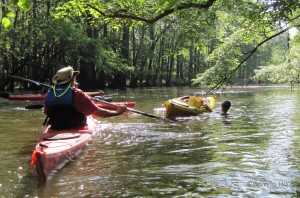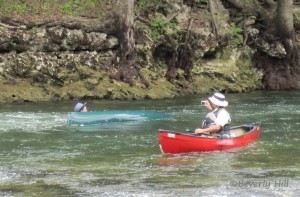Kayaks and canoes are similar in concept yet different enough to cause concerns for many first-time kayakers. The most common question asked by newcomers to the sport is, “What happens if I capsize?” With a capsized canoe the paddler simply falls out of the vessel but may have to battle with a sinking canoe, whereas with a kayak, depending on the size of the cockpit, a paddler may fall into the water or become briefly trapped before exiting the kayak.
Kayaks come in two varieties, sit-in (those with a cockpit) and sit-on-top (those without a cockpit.) Choosing a sit-on-top completely eliminates any claustrophobic feelings of becoming trapped should the kayak capsize. Sit-in kayaks have varying size cockpits and may even come with a spray skirt designed to keep the paddler dry and hold them securely in place, thereby allowing them to perform Eskimo rolls more effectively or allowing them to perform whitewater stunts. Clearly a newcomer to paddling won’t be performing the latter, but what can they expect during a capsize?
What Causes a Kayak to Capsize?
For the most part kayaks are pretty stable and it takes some effort to capsize one. Most capsize situations are due to operator error; paddlers grabbing onto stationary objects in a swift current, overcompensating during course correction or simply rocking the boat too hard. Of course there are those unforeseen situations than can also cause an upset like striking a submerged object such as a log, or even getting capsized by a marine animal.
Recovering from a Capsize
During a capsize the most important tool to have is a calm head. Paddlers should also always wear a life jacket any time they are on the water so if they become separated from the kayak they can remain afloat. Another useful tool is the paddle leash. This will allow the paddler to let go of the paddle without worrying that it will drift away and become lost.
If the kayak overturns, remain calm and allow gravity to help ease you out of the cockpit while pressing against the rim of the cockpit firmly with both hands. Relax the legs and let them slide out without kicking until completely clear of the cockpit. If the kayak has a spray skirt lean all the way forward, grasp the release cords near the front of the cockpit and pull forward and up. This will free the spray skirt allowing the paddler to exit the cockpit in the previous example.
Once clear of the kayak it’s a simple matter of popping up to assess the situation. If the kayak is clear of any debris such as a log jam, bridge supports or rocks, try to grab it and either swim with it to a bank or reenter it from the water if familiar with wet reentry. A paddle float or stirrup can assist with wet reentry. Kayak pumps are also very useful in emptying water from a flooded cockpit without having to turn it over.
If the kayak is not in a safe location or too far away, rescue yourself first. The last thing a swimmer needs to do is get caught in a strainer or other dangerous situation. Other paddlers in the group may be able to tow the kayak to shore where it can be emptied of water and safely reentered.
More Useful Kayaking Techniques
Paddlers may want to familiarize themselves with wet reentry by taking the time to practice in calm water and going through the various methods to discover which one is best for them. Another valuable tool would be to take a kayaking clinic and learn the Eskimo roll which allows the kayak to be righted without exiting it, an almost necessary skill for long distance sea kayakers. The ultimate goal is to have the proper skills to be safe and confident while on the water.
[amazon_enhanced asin=”B0015VAV9I” /]


